Imputation of Taxation on Dividend Policy
VerifiedAdded on 2023/06/04
|7
|1475
|69
AI Summary
This literature review focuses on the impact of imputation of taxation on the dividend policy of Australian firms and its effect on taxation of income. Factors such as tax policy and cash flow determine target payout ratios in Australia. The review also elaborates on the impact of differential taxes on capital gains and dividends on individual investors. The paper concludes with a discussion on the gap in explaining dividend distribution events and the need for future research.
Contribute Materials
Your contribution can guide someone’s learning journey. Share your
documents today.
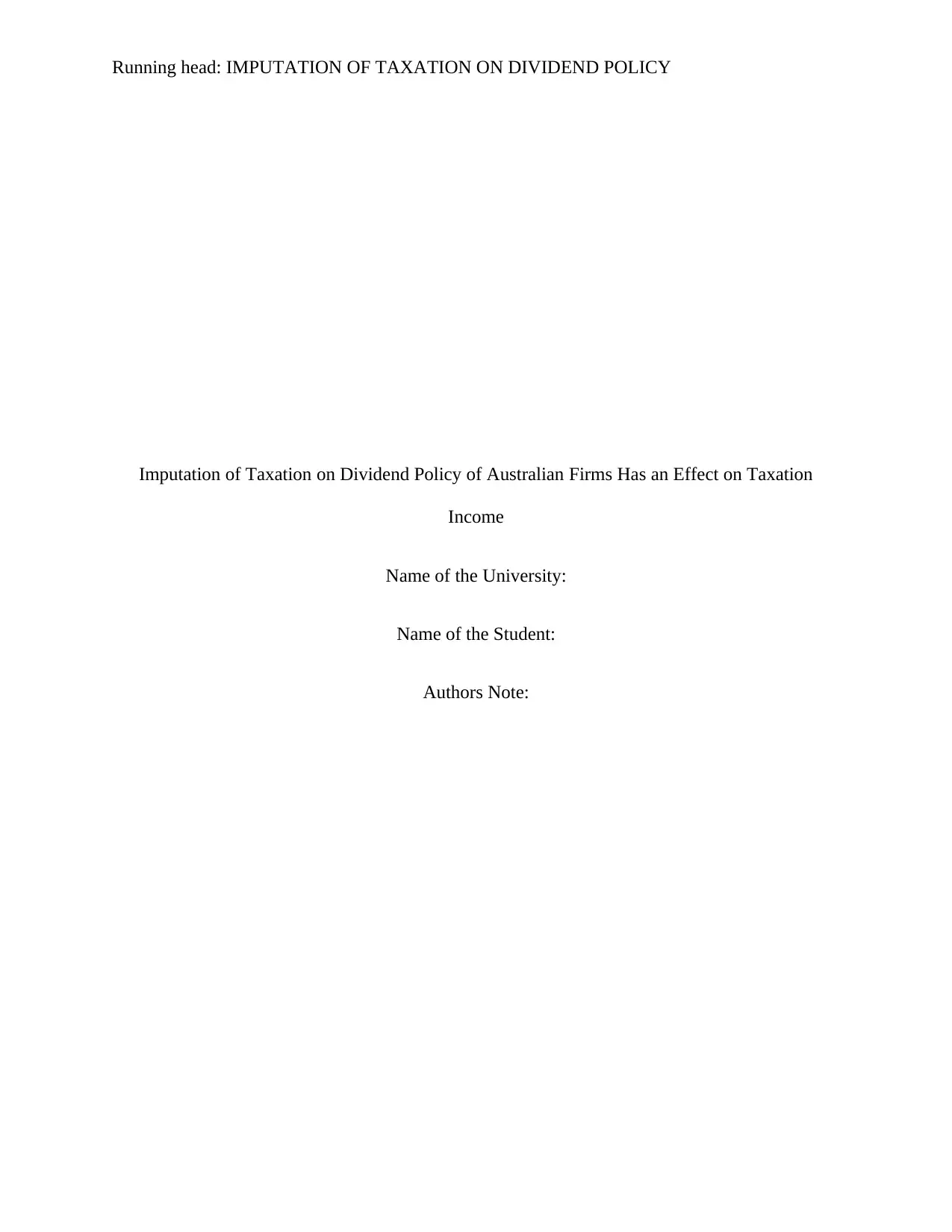
Running head: IMPUTATION OF TAXATION ON DIVIDEND POLICY
Imputation of Taxation on Dividend Policy of Australian Firms Has an Effect on Taxation
Income
Name of the University:
Name of the Student:
Authors Note:
Imputation of Taxation on Dividend Policy of Australian Firms Has an Effect on Taxation
Income
Name of the University:
Name of the Student:
Authors Note:
Secure Best Marks with AI Grader
Need help grading? Try our AI Grader for instant feedback on your assignments.
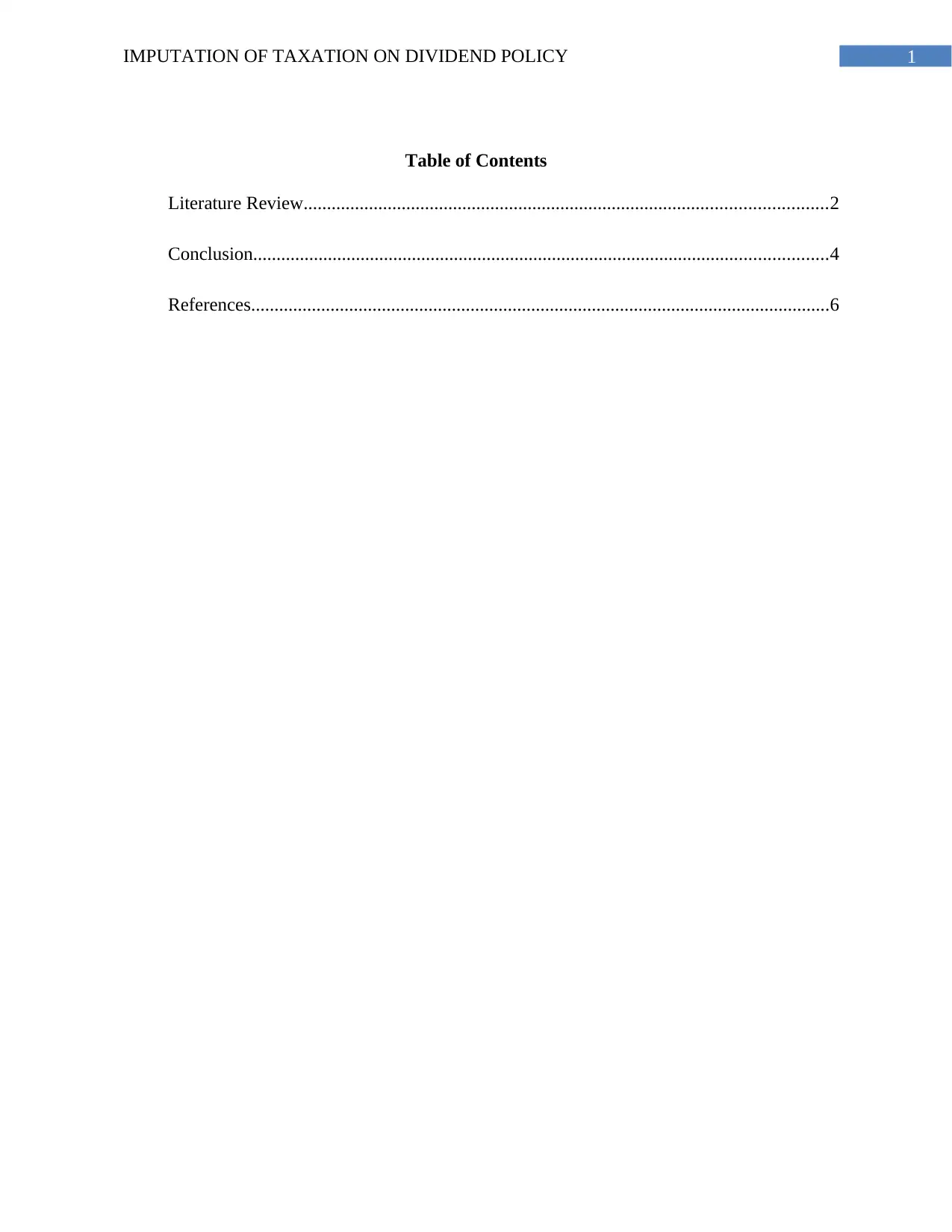
1IMPUTATION OF TAXATION ON DIVIDEND POLICY
Table of Contents
Literature Review................................................................................................................2
Conclusion...........................................................................................................................4
References............................................................................................................................6
Table of Contents
Literature Review................................................................................................................2
Conclusion...........................................................................................................................4
References............................................................................................................................6
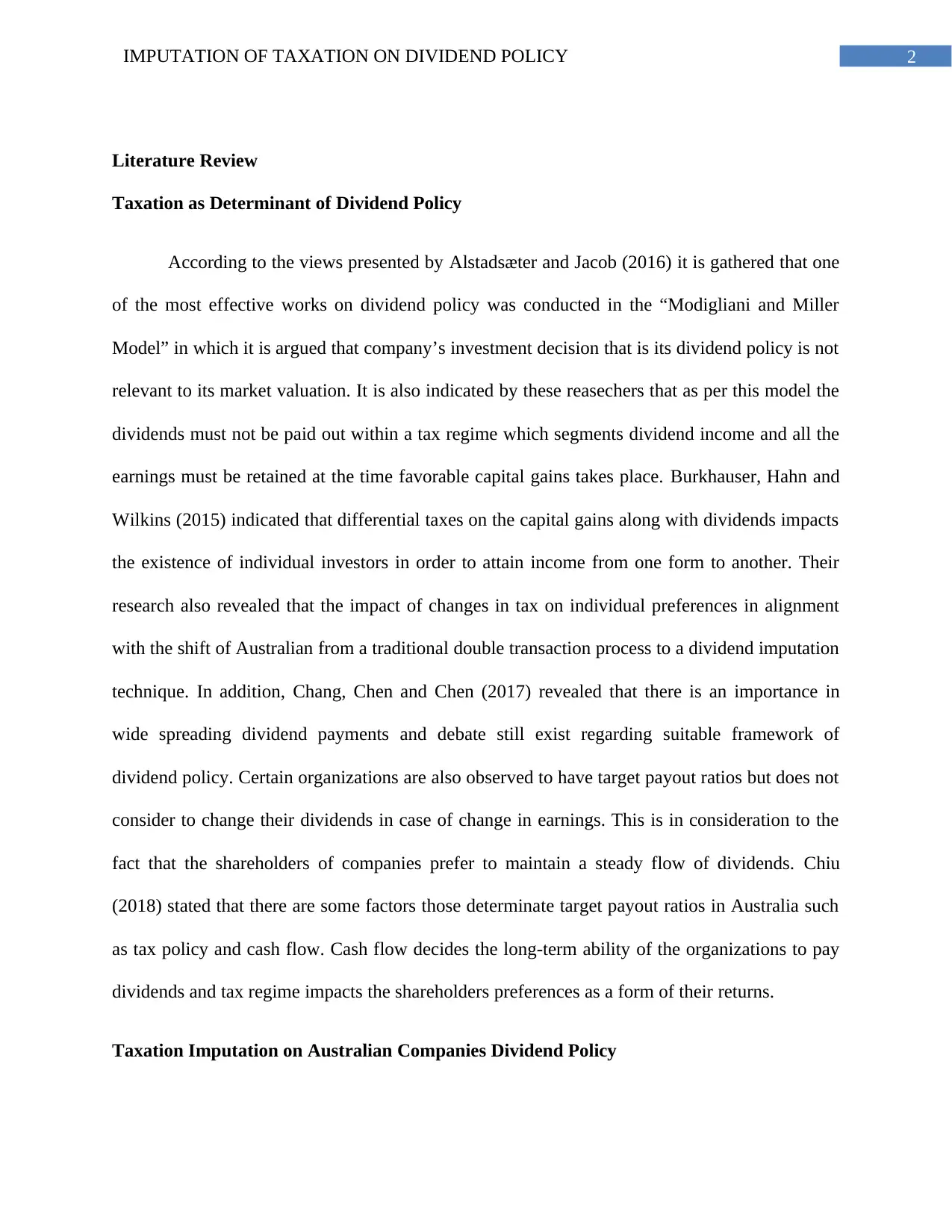
2IMPUTATION OF TAXATION ON DIVIDEND POLICY
Literature Review
Taxation as Determinant of Dividend Policy
According to the views presented by Alstadsæter and Jacob (2016) it is gathered that one
of the most effective works on dividend policy was conducted in the “Modigliani and Miller
Model” in which it is argued that company’s investment decision that is its dividend policy is not
relevant to its market valuation. It is also indicated by these reasechers that as per this model the
dividends must not be paid out within a tax regime which segments dividend income and all the
earnings must be retained at the time favorable capital gains takes place. Burkhauser, Hahn and
Wilkins (2015) indicated that differential taxes on the capital gains along with dividends impacts
the existence of individual investors in order to attain income from one form to another. Their
research also revealed that the impact of changes in tax on individual preferences in alignment
with the shift of Australian from a traditional double transaction process to a dividend imputation
technique. In addition, Chang, Chen and Chen (2017) revealed that there is an importance in
wide spreading dividend payments and debate still exist regarding suitable framework of
dividend policy. Certain organizations are also observed to have target payout ratios but does not
consider to change their dividends in case of change in earnings. This is in consideration to the
fact that the shareholders of companies prefer to maintain a steady flow of dividends. Chiu
(2018) stated that there are some factors those determinate target payout ratios in Australia such
as tax policy and cash flow. Cash flow decides the long-term ability of the organizations to pay
dividends and tax regime impacts the shareholders preferences as a form of their returns.
Taxation Imputation on Australian Companies Dividend Policy
Literature Review
Taxation as Determinant of Dividend Policy
According to the views presented by Alstadsæter and Jacob (2016) it is gathered that one
of the most effective works on dividend policy was conducted in the “Modigliani and Miller
Model” in which it is argued that company’s investment decision that is its dividend policy is not
relevant to its market valuation. It is also indicated by these reasechers that as per this model the
dividends must not be paid out within a tax regime which segments dividend income and all the
earnings must be retained at the time favorable capital gains takes place. Burkhauser, Hahn and
Wilkins (2015) indicated that differential taxes on the capital gains along with dividends impacts
the existence of individual investors in order to attain income from one form to another. Their
research also revealed that the impact of changes in tax on individual preferences in alignment
with the shift of Australian from a traditional double transaction process to a dividend imputation
technique. In addition, Chang, Chen and Chen (2017) revealed that there is an importance in
wide spreading dividend payments and debate still exist regarding suitable framework of
dividend policy. Certain organizations are also observed to have target payout ratios but does not
consider to change their dividends in case of change in earnings. This is in consideration to the
fact that the shareholders of companies prefer to maintain a steady flow of dividends. Chiu
(2018) stated that there are some factors those determinate target payout ratios in Australia such
as tax policy and cash flow. Cash flow decides the long-term ability of the organizations to pay
dividends and tax regime impacts the shareholders preferences as a form of their returns.
Taxation Imputation on Australian Companies Dividend Policy
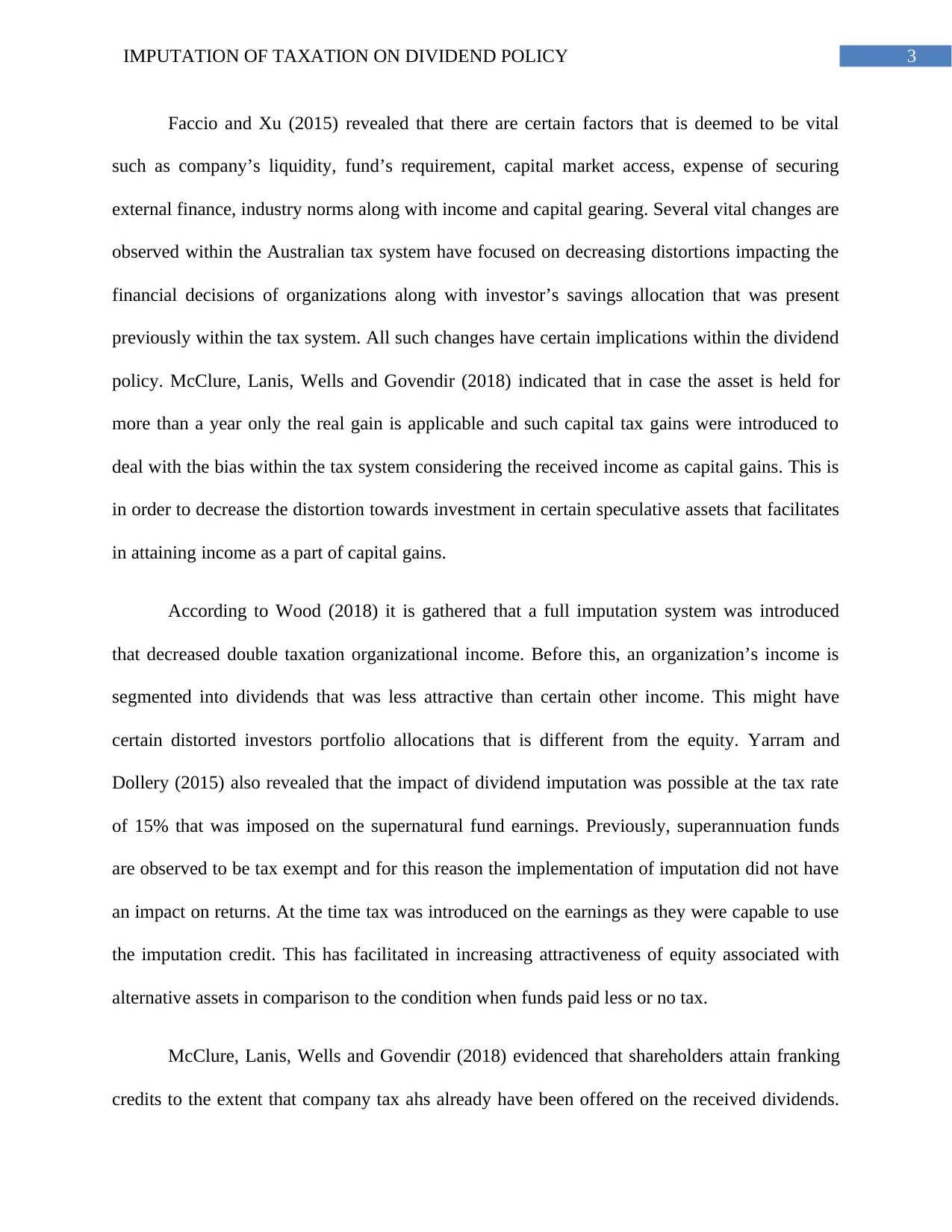
3IMPUTATION OF TAXATION ON DIVIDEND POLICY
Faccio and Xu (2015) revealed that there are certain factors that is deemed to be vital
such as company’s liquidity, fund’s requirement, capital market access, expense of securing
external finance, industry norms along with income and capital gearing. Several vital changes are
observed within the Australian tax system have focused on decreasing distortions impacting the
financial decisions of organizations along with investor’s savings allocation that was present
previously within the tax system. All such changes have certain implications within the dividend
policy. McClure, Lanis, Wells and Govendir (2018) indicated that in case the asset is held for
more than a year only the real gain is applicable and such capital tax gains were introduced to
deal with the bias within the tax system considering the received income as capital gains. This is
in order to decrease the distortion towards investment in certain speculative assets that facilitates
in attaining income as a part of capital gains.
According to Wood (2018) it is gathered that a full imputation system was introduced
that decreased double taxation organizational income. Before this, an organization’s income is
segmented into dividends that was less attractive than certain other income. This might have
certain distorted investors portfolio allocations that is different from the equity. Yarram and
Dollery (2015) also revealed that the impact of dividend imputation was possible at the tax rate
of 15% that was imposed on the supernatural fund earnings. Previously, superannuation funds
are observed to be tax exempt and for this reason the implementation of imputation did not have
an impact on returns. At the time tax was introduced on the earnings as they were capable to use
the imputation credit. This has facilitated in increasing attractiveness of equity associated with
alternative assets in comparison to the condition when funds paid less or no tax.
McClure, Lanis, Wells and Govendir (2018) evidenced that shareholders attain franking
credits to the extent that company tax ahs already have been offered on the received dividends.
Faccio and Xu (2015) revealed that there are certain factors that is deemed to be vital
such as company’s liquidity, fund’s requirement, capital market access, expense of securing
external finance, industry norms along with income and capital gearing. Several vital changes are
observed within the Australian tax system have focused on decreasing distortions impacting the
financial decisions of organizations along with investor’s savings allocation that was present
previously within the tax system. All such changes have certain implications within the dividend
policy. McClure, Lanis, Wells and Govendir (2018) indicated that in case the asset is held for
more than a year only the real gain is applicable and such capital tax gains were introduced to
deal with the bias within the tax system considering the received income as capital gains. This is
in order to decrease the distortion towards investment in certain speculative assets that facilitates
in attaining income as a part of capital gains.
According to Wood (2018) it is gathered that a full imputation system was introduced
that decreased double taxation organizational income. Before this, an organization’s income is
segmented into dividends that was less attractive than certain other income. This might have
certain distorted investors portfolio allocations that is different from the equity. Yarram and
Dollery (2015) also revealed that the impact of dividend imputation was possible at the tax rate
of 15% that was imposed on the supernatural fund earnings. Previously, superannuation funds
are observed to be tax exempt and for this reason the implementation of imputation did not have
an impact on returns. At the time tax was introduced on the earnings as they were capable to use
the imputation credit. This has facilitated in increasing attractiveness of equity associated with
alternative assets in comparison to the condition when funds paid less or no tax.
McClure, Lanis, Wells and Govendir (2018) evidenced that shareholders attain franking
credits to the extent that company tax ahs already have been offered on the received dividends.
Secure Best Marks with AI Grader
Need help grading? Try our AI Grader for instant feedback on your assignments.
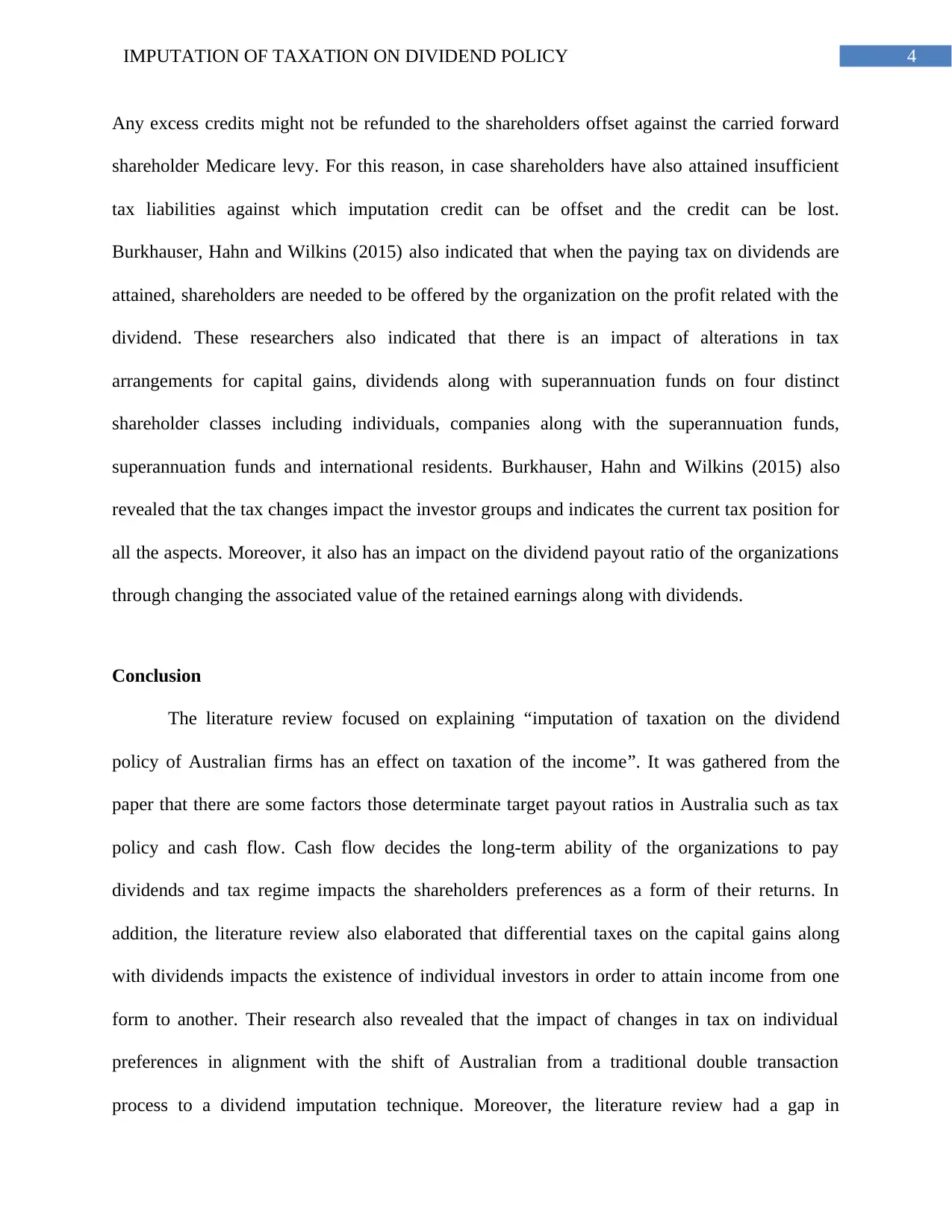
4IMPUTATION OF TAXATION ON DIVIDEND POLICY
Any excess credits might not be refunded to the shareholders offset against the carried forward
shareholder Medicare levy. For this reason, in case shareholders have also attained insufficient
tax liabilities against which imputation credit can be offset and the credit can be lost.
Burkhauser, Hahn and Wilkins (2015) also indicated that when the paying tax on dividends are
attained, shareholders are needed to be offered by the organization on the profit related with the
dividend. These researchers also indicated that there is an impact of alterations in tax
arrangements for capital gains, dividends along with superannuation funds on four distinct
shareholder classes including individuals, companies along with the superannuation funds,
superannuation funds and international residents. Burkhauser, Hahn and Wilkins (2015) also
revealed that the tax changes impact the investor groups and indicates the current tax position for
all the aspects. Moreover, it also has an impact on the dividend payout ratio of the organizations
through changing the associated value of the retained earnings along with dividends.
Conclusion
The literature review focused on explaining “imputation of taxation on the dividend
policy of Australian firms has an effect on taxation of the income”. It was gathered from the
paper that there are some factors those determinate target payout ratios in Australia such as tax
policy and cash flow. Cash flow decides the long-term ability of the organizations to pay
dividends and tax regime impacts the shareholders preferences as a form of their returns. In
addition, the literature review also elaborated that differential taxes on the capital gains along
with dividends impacts the existence of individual investors in order to attain income from one
form to another. Their research also revealed that the impact of changes in tax on individual
preferences in alignment with the shift of Australian from a traditional double transaction
process to a dividend imputation technique. Moreover, the literature review had a gap in
Any excess credits might not be refunded to the shareholders offset against the carried forward
shareholder Medicare levy. For this reason, in case shareholders have also attained insufficient
tax liabilities against which imputation credit can be offset and the credit can be lost.
Burkhauser, Hahn and Wilkins (2015) also indicated that when the paying tax on dividends are
attained, shareholders are needed to be offered by the organization on the profit related with the
dividend. These researchers also indicated that there is an impact of alterations in tax
arrangements for capital gains, dividends along with superannuation funds on four distinct
shareholder classes including individuals, companies along with the superannuation funds,
superannuation funds and international residents. Burkhauser, Hahn and Wilkins (2015) also
revealed that the tax changes impact the investor groups and indicates the current tax position for
all the aspects. Moreover, it also has an impact on the dividend payout ratio of the organizations
through changing the associated value of the retained earnings along with dividends.
Conclusion
The literature review focused on explaining “imputation of taxation on the dividend
policy of Australian firms has an effect on taxation of the income”. It was gathered from the
paper that there are some factors those determinate target payout ratios in Australia such as tax
policy and cash flow. Cash flow decides the long-term ability of the organizations to pay
dividends and tax regime impacts the shareholders preferences as a form of their returns. In
addition, the literature review also elaborated that differential taxes on the capital gains along
with dividends impacts the existence of individual investors in order to attain income from one
form to another. Their research also revealed that the impact of changes in tax on individual
preferences in alignment with the shift of Australian from a traditional double transaction
process to a dividend imputation technique. Moreover, the literature review had a gap in
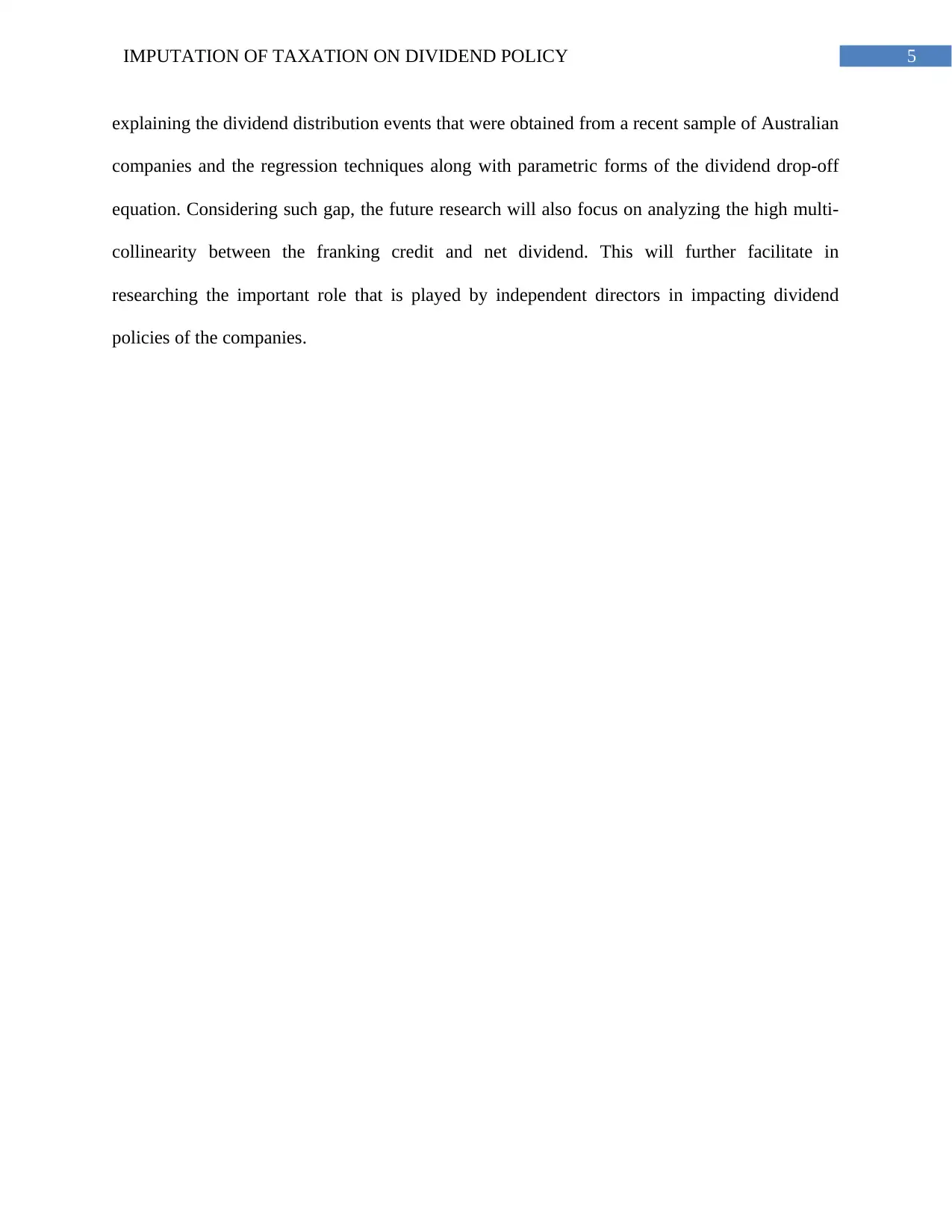
5IMPUTATION OF TAXATION ON DIVIDEND POLICY
explaining the dividend distribution events that were obtained from a recent sample of Australian
companies and the regression techniques along with parametric forms of the dividend drop-off
equation. Considering such gap, the future research will also focus on analyzing the high multi-
collinearity between the franking credit and net dividend. This will further facilitate in
researching the important role that is played by independent directors in impacting dividend
policies of the companies.
explaining the dividend distribution events that were obtained from a recent sample of Australian
companies and the regression techniques along with parametric forms of the dividend drop-off
equation. Considering such gap, the future research will also focus on analyzing the high multi-
collinearity between the franking credit and net dividend. This will further facilitate in
researching the important role that is played by independent directors in impacting dividend
policies of the companies.
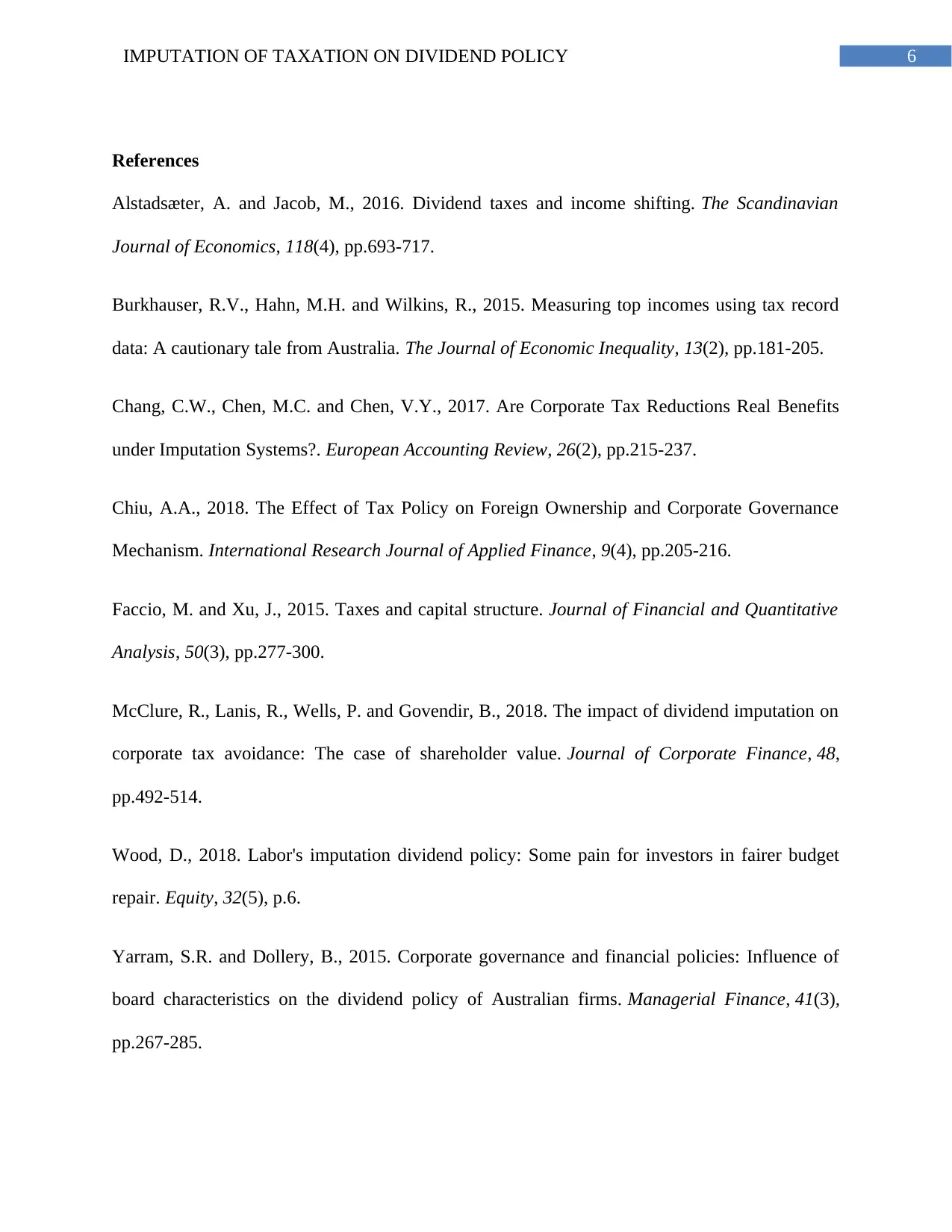
6IMPUTATION OF TAXATION ON DIVIDEND POLICY
References
Alstadsæter, A. and Jacob, M., 2016. Dividend taxes and income shifting. The Scandinavian
Journal of Economics, 118(4), pp.693-717.
Burkhauser, R.V., Hahn, M.H. and Wilkins, R., 2015. Measuring top incomes using tax record
data: A cautionary tale from Australia. The Journal of Economic Inequality, 13(2), pp.181-205.
Chang, C.W., Chen, M.C. and Chen, V.Y., 2017. Are Corporate Tax Reductions Real Benefits
under Imputation Systems?. European Accounting Review, 26(2), pp.215-237.
Chiu, A.A., 2018. The Effect of Tax Policy on Foreign Ownership and Corporate Governance
Mechanism. International Research Journal of Applied Finance, 9(4), pp.205-216.
Faccio, M. and Xu, J., 2015. Taxes and capital structure. Journal of Financial and Quantitative
Analysis, 50(3), pp.277-300.
McClure, R., Lanis, R., Wells, P. and Govendir, B., 2018. The impact of dividend imputation on
corporate tax avoidance: The case of shareholder value. Journal of Corporate Finance, 48,
pp.492-514.
Wood, D., 2018. Labor's imputation dividend policy: Some pain for investors in fairer budget
repair. Equity, 32(5), p.6.
Yarram, S.R. and Dollery, B., 2015. Corporate governance and financial policies: Influence of
board characteristics on the dividend policy of Australian firms. Managerial Finance, 41(3),
pp.267-285.
References
Alstadsæter, A. and Jacob, M., 2016. Dividend taxes and income shifting. The Scandinavian
Journal of Economics, 118(4), pp.693-717.
Burkhauser, R.V., Hahn, M.H. and Wilkins, R., 2015. Measuring top incomes using tax record
data: A cautionary tale from Australia. The Journal of Economic Inequality, 13(2), pp.181-205.
Chang, C.W., Chen, M.C. and Chen, V.Y., 2017. Are Corporate Tax Reductions Real Benefits
under Imputation Systems?. European Accounting Review, 26(2), pp.215-237.
Chiu, A.A., 2018. The Effect of Tax Policy on Foreign Ownership and Corporate Governance
Mechanism. International Research Journal of Applied Finance, 9(4), pp.205-216.
Faccio, M. and Xu, J., 2015. Taxes and capital structure. Journal of Financial and Quantitative
Analysis, 50(3), pp.277-300.
McClure, R., Lanis, R., Wells, P. and Govendir, B., 2018. The impact of dividend imputation on
corporate tax avoidance: The case of shareholder value. Journal of Corporate Finance, 48,
pp.492-514.
Wood, D., 2018. Labor's imputation dividend policy: Some pain for investors in fairer budget
repair. Equity, 32(5), p.6.
Yarram, S.R. and Dollery, B., 2015. Corporate governance and financial policies: Influence of
board characteristics on the dividend policy of Australian firms. Managerial Finance, 41(3),
pp.267-285.
1 out of 7
Related Documents
Your All-in-One AI-Powered Toolkit for Academic Success.
+13062052269
info@desklib.com
Available 24*7 on WhatsApp / Email
![[object Object]](/_next/static/media/star-bottom.7253800d.svg)
Unlock your academic potential
© 2024 | Zucol Services PVT LTD | All rights reserved.





